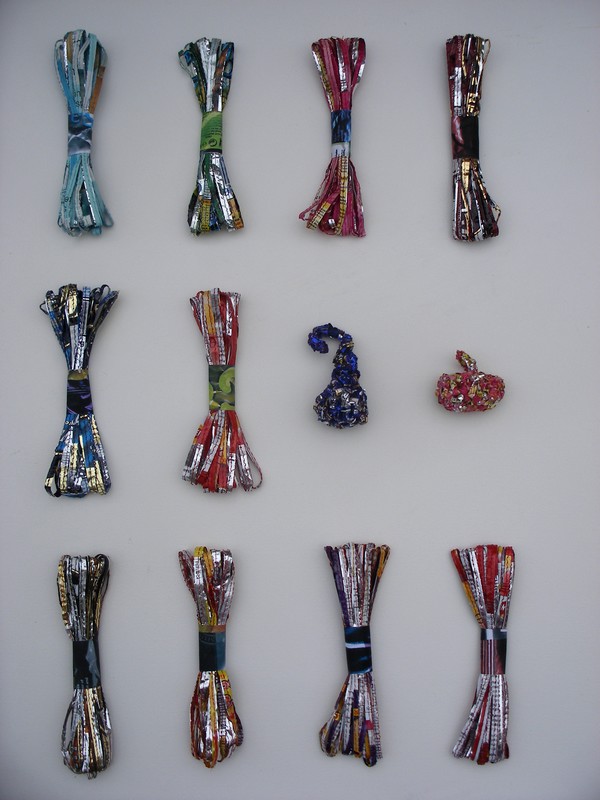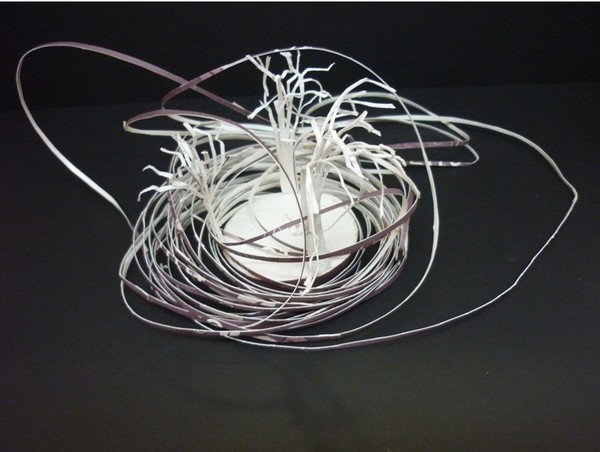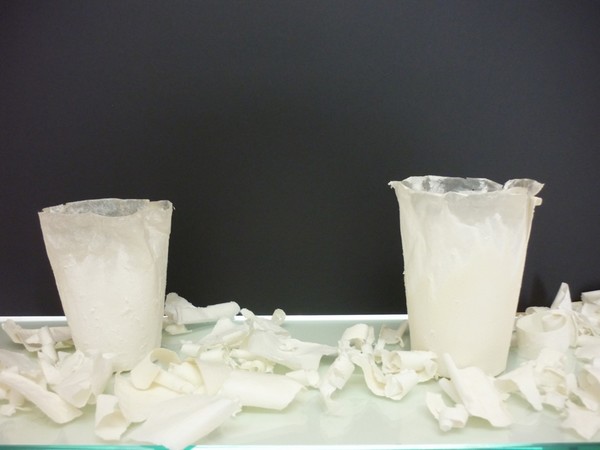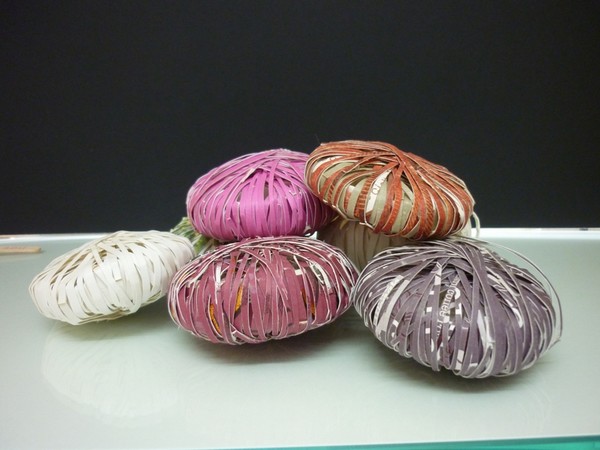Responses, redefinitions and repositionings
Creativity as a new direction in eco-philosophy
More ‘re’ words
I have framed this paper and my current research thinking into a series of seven ‘re’ words.
Using these words implies a ‘doing again’, a dis-satisfaction with what has gone before, a feeling of things not being right.
1. Revolution
The movement known as ‘craftivism’ has been described as a craft revolution; this initially seems to be a contradiction in terms as revolutions can often be violent and brutal, as recently seen. This paper examines the incongruity between the (relatively) new found popularity of textile craft processes and the use made of web-based social networking sites resulting in a powerful movement which promotes anti-capitalist, anti-war and environmental and sustainability messages, resulting in a ‘revolution’, but not as we know it.
2. Researching
My own work is currently based around a practice-based Phd; researching ways in which textile art and textile craft processes can contribute to a dialogue between art, materials and social and cultural change.
3. Resources
The current use, or rather mis-use of resources plays an important part in my work; I re-examine, re-evaluate and re-configure materials usually taken for granted and discarded.
4. Reflecting
Low-tech textile craft methods leave space and time for reflection, thinking and perhaps a little dreaming. In a consumer driven culture that expects us to be busy and productive, the act of making ‘just for the love of it’ becomes a political act, subverting notions of ‘exchange value’ necessary to sustain a capitalist system.
5. Reconnect
What is the meaning of making in the twenty first century; why do we need it; what is its relevance?
Is there a current feeling of disillusionment with our ‘commodified’ culture?
How do we reconnect with ourselves, with each other and with society?
I will be looking at David Gauntlett’s book ‘Making is Connecting’ (Gauntlett, 2011) where he discusses the social meaning of creativity from DIY and knitting to You Tube (www.youtube.com) and Web 2.0
6. Remix
According to Lawrence Lessig a ‘remix’ culture is one where people are free to add, change, influence and interact with their culture. In his 2008 book ‘Remix Making art and commerce thrive in the hybrid economy’, he describes how we could and should use technology to benefit those who make and consume art. This process is facilitated by the use of Web 2.0, making it an adaptable medium for participation with craftivism initiatives/websites and a perfect platform for the dissemination of ideas and information.
7. Redefinition
At a time of economic and societal unrest and uncertainty new paradigms are needed and answers to the question of how the role of artists and practitioners can be redefined for the twenty first century.
How can we define these positive changes, search for a different set of values, a new form of ‘eco-philosophy’, with creativity at its heart, which can sustain us for the future?
I will elaborate a little on each of these words
Revolution
How can a ‘craft revolution’ or ‘craftivism’ have any impact in our modern fast-moving world?
Revolutions, usually, are initiated by people who have no other way to be heard or considered and are often brutal, reckless and violent.
‘Craftivism’ is a form of activism (activism can take a wide variety of forms – but consists of intentional efforts to bring about social, political, economic or environmental change) and, as already stated, typically includes elements of anti-capitalist, anti-war movements, environmentalism and third wave feminism, that is centred around practices of craft – quite often around knitting.
These are some quotes from the American Betsy Greer, who describes herself as an ‘asker of questions’, but she is much more than that; she has been attributed with the coining of the term ‘craftivism’ but by her own admission she ‘found’ the word and nurtured it, within a couple of years giving it its own website and blog, starting with just a word and an idea.
‘After all old people knit, right? Maybe I could find a place to colunteer where I could be taught knitting techniques while keeping someone company! I would be helping to preserve craft’s oral traditions and aiding someone simultaneously! Genius!’ Greer,Betsy (2011) ‘Craftivist History’, in Maria Elena Buszek (ed.) Extra/Ordinary Craft and Contemporary Art; Duke University Press, p176.
‘Craftivism was, for me, a way to actively recognise and remember my place in the world, a way to remember how I can take steps toward being an agent of change. Small change? Of course. But done continually and repetitively, small changes aggregate and spread.’ ’ Ibid., p180.
We have just witnessed the 10th anniversary of 9/11 and it was these events and the following military action that intensified her feelings of anger and sense of helplessness; she found her ability to knit strangely comforting.
She began to consider the intrinsic connection between the words ‘craft’ – which she thought seemed ‘like the younger child not taken seriously by art’ and ‘activism’ which she felt ‘ made people feel uncomfortable, conjuring unpleasant images of tear gas and riot gear.’ Greer, Betsy (2011) ‘Craftivist History’, in Maria Elena Buszek (ed.) Extra / Ordinary Craft and Contemporary Art; Duke University Press, p178.
Two positive words, she felt, had been culturally redefined as negative and she wondered if that by combining the two in a new way a positive energy and force for good would result.
Her development of the term ‘craftivism’ was also the result of a conversation with a fellow crafter and she had also noticed that it had been used by a US online collective called the Church of Craft.
The Church of Craft is interesting – not to be confused with the Church of Stop Shopping, – the Reverend Billy and the Church of Stop Shopping is well worth investigating by the way, recently seen at Tate Modern and the ‘Occupy’ protests. I don’t know the best way to describe these ‘movements’, can they be called activist performance art? There is a thesis in there somewhere- but they are certainly both ‘artworks’.
The Church of Craft was started by artist Callie Janoff who in the year 2000 had had a bit of a eureka moment when, after having herself ordained by the Universal Life Church (which you can do on-line apparently) officiated at a friend’s wedding. She was thinking at this time of the best way to marry, so to speak, creativity and spirituality and came up with the idea of the Church of Craft. It began informally during the spring of 2000 in the Bay area of California as a collaboration between Janoff and her friend Tristy Taylor who at that time lived in New York, so by using the internet as a channel of communication various groups or ‘chapters’ sprung up and ‘craft-ons’ were being organised by an online network with groups on opposite sides of America. The Church of Craft stresses its non-denominational status and writes eloquently about spirituality and making and how we can reconcile the two in our modern lives.
Participants would come together in coffee houses or other public places to meet, talk and make. This is a very overt form of making, not covert, at home, hidden, but out in the community, for everyone to see.
‘….we are very well bred consumers, that is to say- we have learned well how to consume our food, culture, knowledge, power. Consumption is passive and we seek the path of least resistance….’
‘….this church’s purpose is to be a constant act of creation……this church’s purpose is to help us see the power that creativity and making works in our lives……’
‘….we come together and we make things, and we affirm the craft we see in each other. Then we go home inspired, confident, peaceful and we live our lives with all the happiness we can.’
Sermon Church of craft (www.churchofcraft)
So in this sense, church means community, and ‘craftivism’, as Betsy Greer believes, is also about community.
Digital technological advances mean that now most occupations, both work-based and leisure-based, involve long periods of time looking at a screen – time which perhaps could be better spent engaging with the material world. However having access to this technology – particularly web-based social/interest based networks and blogs means having an ability to share, respond and create with like-minded people.
So what sort of revolution is this, not a revolution in the normal sense of the word, it is certainly softer, pinker, does not make news headlines, not yet, but it is there if you know where to look.
I would like you to consider the possibility of a pink revolution, not a new term I know, but one which seems appropriate here, in fact by the end of this paper you will all have been part of a local pink revolution – you will soon find coming your way some partially knitted pink yarn – please knit a stitch and pass it on, if this is daunting just mime – you will not be judged – a teacher friend assures me that if hands are busy listening skills are increased.
This iconic image of Danish artist Marianne Jorgensen’s Pink M.24 Chaffee from 2006 shows us another way to make a statement, a protest, another way to make our voices heard. The tank has been covered in over 4000 pink squares, collected by the artist including members of the London-based Cast Off knitting group after an invitation to various networks. The piece was also contributed to by people in the street who would not normally involve themselves in anti-war activities. The artist describes this process as ‘knitting your opinions’ and the final result as a ‘visualisation of thoughtfulness’ ( www. marianneart.dk )
The colour pink dilutes the menace and aggression of the tank, the hours of work involved shows caring and humanness of participants – for no financial gain, believing that they could make a positive difference by contributing to this work. By being engaged in such making there is a sense of involvement, a belief in the ability to ‘make things better’, of the possibility of shaping society in a subtle yet powerful way.
This is ‘work’, but in a different ‘economy’, but more of that later.
Researching
I am currently researching, by means of a practice based Phd the ways in which textile art and processes can contribute to a dialogue, a conversation, a reciprocal process, both virtual and physical, between art-making, materials and social and cultural change. I often invite my audience to become a participant and engage in the making process – as you have here today.
This is a video made by Marc le Galle from Bath Spa University.
http://www.youtube.com/watch?v=4Uwin9azXZI
I recently took my knitting chair and materials into college and invited students, lecturers, complete strangers to join me in my making; knitting and crocheting yarn made from discarded crisp packets. I knit and unpick, emphasising the fact that this material never goes away, it has nowhere to go, being neither bio-degradable or recyclable.
People do not generally recognise these materials; they are not usually noticed, hardly handled, and then discarded. It is a surprise for participants to discover that over six metres of yarn can be produced from one bag and they are always concerned that this must take me a long time, which actually it doesn’t. Hence public knitting, whether it be in the gallery or on the street becomes a performative and accessible political statement, a tacit display of agency, questioning attitudes towards materials, consumerism and how we spend our time. I have had some great conversations over knitting – people seem to trust you if you knit!
Resources
‘Globally people are using about twenty five per cent more natural resources than the planet can replace. In the UK we’re consuming three times our fair share of the planet’s natural resources. In the western world we live and consume as if we have three planets at our disposal instead of one.’ Alarming facts from the World Wildlife Fund for Nature website (www.wwf.org.uk)

So part of my practice is to re-emphasise how much material both physical and also embodied energy is gobbled up by this snack of dubious nutritional value. I sometimes rework these packets into a flower and replace it where it was found, hoping that by giving these materials a value, by spending time working with them – they are aluminium (which has had to be mined, processed and shipped halfway across the world) aluminium backed plastic (from oil which has also been extracted from wells, shipped, processed, printed etc. ) – and that’s just the packaging, I can make people think twice about the provenance of these things, where they go and also (hopefully) to ask the question do we really need them. Eleven million of these packs are sold each day, by the way and that is just one company.

I am currently fascinated by paper coffee cups, another single use product, which on further investigation are not totally paper but have a layer of plastic inside, making them difficult to recycle. I cut these cups into a fine ‘yarn’, thus ‘releasing’ about fifteen metres of this material, this is sometimes ‘wound’ around the base to produce a ball of paper yarn in readiness for something else.

By just peeling away layers of the softened paper the cups become almost like porcelain revealing a sense of permanence that wasn’t present before. By leaving the pile of peelings again I am attempting to show just how many resources, how much material is incorporated into this product. I like the challenge of working with these industrially made materials – which are machine- made in their millions. I am rescuing them, reforming them, giving them another life; searching for an aesthetic to be found in the mundane and the ordinary.
Reflecting
Using these low-tech methods leaves space and time for reflection; by hand, cutting, stitching – sometimes with a sewing machine, knitting; reflection on why there is such a proliferation of materials still being made that do not degrade.

I am making this space important both on a physical and intellectual level and participative processes and projects emphasise the need and desire to open up a dialogue about environmental concerns and issues. I am questioning attitudes to process and materials in a society where craft skills are increasingly less taught but where the term ’hand-made’ has an almost mystical resonance, something picked up on by the marketing world in recent advertising campaigns.
Coming back to Betsy Greer, (Greer, 2011) she talks of an ‘innate need to create’ – this is something that can happen ‘un-judged’ in these on-line networks, not part of an art school curriculum, with all the ensuing pressures of marketplace and competition.
I am aware that many traditional textile craft processes evolved out of necessity; a need for clothing, warmth, or more prosaically ways to make your domestic setting, your home, more comfortable. We do not need to make these things in the twenty first century, our fashion and design industries are very good at already making things look ‘handmade’ as style dictates and it is not always cheaper to make your own unless you re-use your materials. But there is a choosing of craft; a renewed interest in knit, crochet, stitch, essentially making but also a coming together of people, a forming of networks and this covers a much younger age group than would normally have been expected to have an interest in these activities. Technology, perversely, has played an important part in making craft ‘cool’.
So, in a consumer driven culture that expects us to be busy and productive, the act of making ‘just for the love of it’ becomes a political act, subverting notions of ‘exchange value’ necessary to sustain a capitalist system. Much of this movement is based on an ethos of sharing and emphasises the importance of not only making but also, when you buy, to buy hand-made, thus supporting other makers and an alternative economy. This is a reaction against globalisation and inherent in this is a concern over conditions of work in areas of production and the negative impact mass production has on the environment. There is an excitement and energy about these networks which also offers a democratisation of skills, knowledge, sharing. They are feely accessible, open to anyone. Many blogs exist both on a ‘professional’ level, if you like, from textile artists and makers as well as those from people who would be uncomfortable with that title but know that making is an important part of their lives.
Reconnect
It is interesting that David Gauntlett, a Professor of Media Studies at Westminster University should choose this time to write a book called ‘Making is Connecting’ (Gauntlett, 2011). In this book he discusses the social meaning of making and creativity from and how digital participatory cultures can lead to positive transformations in our society.
As you know Web 1.0 was, or is, people having individual websites and keeping themselves to themselves whereas Web 2.0 has many interactive platforms where sites can be joined, added to, used for exchanges of information and communication. Videos, images, podcasts can be downloaded and through social networks it is possible to communicate with people anywhere.
I have already mentioned third-wave feminism and Amy Spencer, author of DIY: The Rise of Lo-Fi Culture is quoted in Gauntlett’s book, describing how the role of the internet and in particular of ‘riot grrrl’ zines was central to establishing the principles of this movement. She says:
Here women redefined feminism for the 90’s and recognised each other as manufacturers of culture, as opposed to participants in a culture that they were encouraged to accept. They were encouraged to reclaim the media and produce their own cultural forms p55.
I have been heartened in researching this paper of the number and the attitude of young women (and some young men) who are actively engaged in purposeful craft; this is their way of changing the world. They are confident, articulate, passionate and well-informed and if I didn’t read their blogs I wouldn’t know this! Their emphasis is definitely on the process of making and they seem to understand the inherent benefits not just for themselves and on a wider caring and sharing social level. Gauntlett states:
Creativity might be better understood as a process, and a feeling. In this way of looking at it, creativity is about breaking new ground, but internally: the sense of going somewhere, doing something that you’ve not done before. This might lead to fruits which others can appreciate, but those may be secondary to the process of creativity itself, which is best identified from within p17.
This is well illustrated in this audio piece ’A delicate rhythm’ by Susi Bancroft;
http://audioboo.fm/boos/427427-susi-bancroft-reading-her-reflections-on-sound-and-making-piece-2
This work can also be found on Amy Houghton’s Tweave website. (www.tweave.co.uk)
This movement has the same values as the Transition Movement ; supporting an alternative economy, doing it yourself and keeping it as local as you can.
Gauntlett also echoes Greer in that in the act of making – ‘even if it is making very small things- the important thing is that people have made a choice – to make something themselves rather than passively consume and this constitutes a political shift in how we deal with the world’ p 19.
Remix
In his 2008 book Remix Lawrence Lessig describes a remix culture as one where the public is free to add, change, influence and interact with their culture, thus making it richer and more inclusive. It is a term used to describe a society which allows and encourages derivative works. Remix is defined as combining or editing existing materials to produce a new product unhindered by issues of copyright, which has been a bone of contention in the past.
Lessig describes modern culture as ‘read only’ meaning a small professional group produces all the culture that is then ‘consumed’ by the masses (analagous to a read only cd which only allows viewing of its content). However remix or read/write culture is one where the public is free to add, change influence and interact with said culture. Lessig argues that read/write culture (analagous to a read/write cd where material can be changed) will nurture creativity by all individuals. In this culture all members are producers who continually consume, remix and produce new material – thus making the culture a creative democracy.
New technologies are taking the making and distribution of creative work out of the hands of solely professionals. Hierarchies are broken down.
So, almost unwittingly, all who use and participate in these networks are contributing to cultural change. One project inspires another In a technological age which is radically shifting and issues of copyright being hotly debated by commercial interests, the internet has become a hotbed of creativity with ‘remixes’ of film, photography, visual art, video, music etc.
Redefinition
I said at the beginning that I would try to seek new ways of defining the positive changes becoming apparent, searching for a new form of ‘eco-philosophy’, with creativity at its heart, which can sustain us for the future.
Could this search which is being expressed by the current wave of nostalgia, of an interest in make do and mend and vintage be resolved by a restoration of the values inherent in traditional textile craft; those of creative thrift, making with ‘love’, of caring, sharing and giving, of innovation, of respect for materials and here we can both undo or revisit in order to remake.
So this paper is not a call to arms but more a call to hands where to make, to do and to mend is a more positive message and is not about giving up anything but seeking an enrichment of our daily lives.
Again quoting Betsy Greer (Greer,2011); ‘craftivism is a way of looking at life where voicing opinions through creativity makes your voice stronger, your compassion deeper and your quest for justice more infinite’.
So I’d just like to finish with a manifesto.
For those who don’t know ‘Prick Your Finger’, it is a shop in Bethnal Green in East London which sells yarn and knitting and craft supplies, sounds pretty ordinary but it is much more than that – being a shop with definite ‘attitude’! It was started by artists Rachael Matthews and Louise Harries who met at Central St Martins College. I have not been to the shop but feel like I have, I have made virtual visits by visiting their blog and website.
It is partly a gallery; they hold workshops, organise musical events, hold parties and initiate various art projects. They have revised their way of looking at the world and this is their manifesto;
We believe
in making your own reality
in making your own clothes
in making sure the earth’s resources aren’t squandered today, leaving nothing for our futures
in making our own yarns
in making old skills and new technologies work together in harmony
in making instead of throwing away
it is possible to live a thoughtful and creative life even when it seems impossible
in making chaos
in making love not war
We believe in making a stand
I hope you do too.
